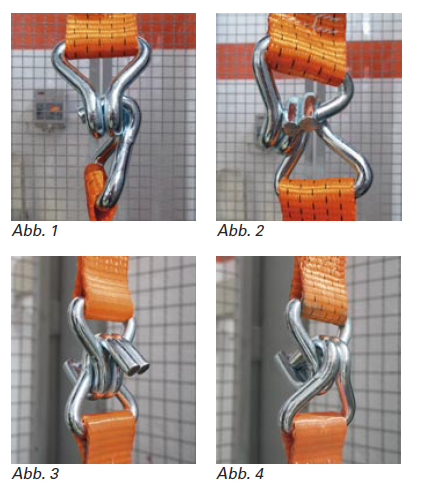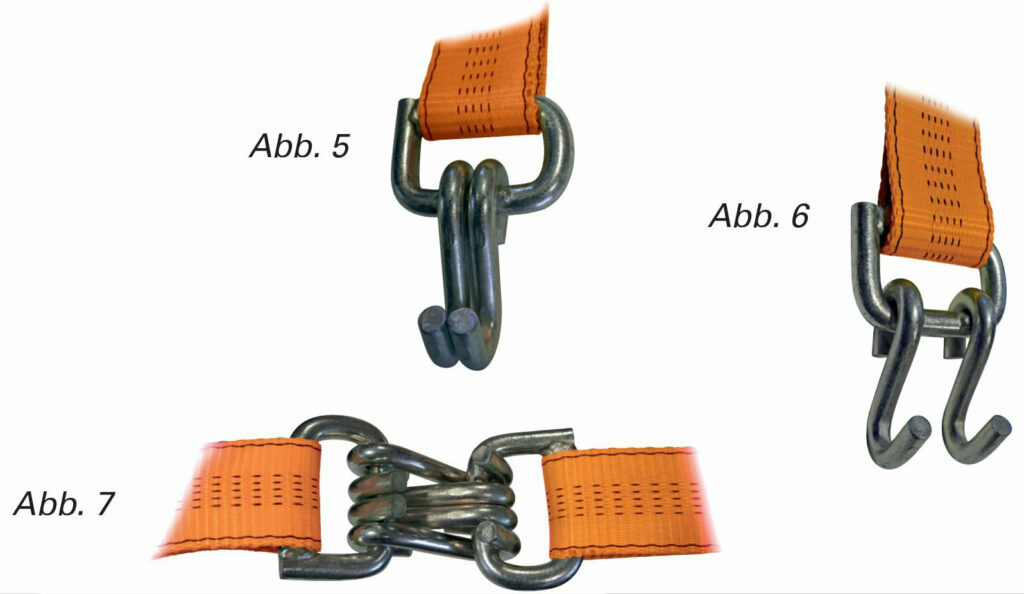Is that safe? – From practice to the test laboratory
We have tested makeshift applications of lashing hook connections for their safety
If you want to bundle loads safely one-piece belts are usually used. However, if the length of the available one-piece tiedown straps is not sufficient for this purpose or if none are available at all two-piece tiedown straps are often used. For bundling their profile hooks are then hooked into each other. Tiedown straps extended or connected in this way are not uncommon in European road traffic. But does this still conform to standards?
Standards and directives do not clearly define whether and which hook connections are permissible. They merely stipulate that hooks may be loaded with tensile stress but not with bending stress. At first glance this is probably not guaranteed for many of the improvised hook connections. So far, however, there are no published tests on the subject. So are such connections safe or not? Our technical team was curious and investigated this question together with Konrad Rainer from the Austrian expert office Cargo Safetytec in the Dolezych Germany test laboratory. The answers that emerged are impressive
Best possible test conditions
The test specimens were profile hooks (often referred to as pointed hooks), which are commonly used as connections of tiedown straps to lashing points or on outer frame hole profiles on the vehicle. On our certified testing machines of accuracy class 1, we tested test arrangements according to Figures 1 – 4.

For the tests we selected exclusively new unused and welded quality hooks of the same type from Dolezych. “We deliberately refrained from combining different hook types from different manufacturers because otherwise we would have had to consider additional influences that we wanted to exclude in our tests” explains Uwe Schöbel, Head of the Technology Department.
Tests expose weak connections
The result of the tests is clear: Most of the tested lashing hook connection methods are not safe! “The majority of the hook combinations did not even survive the load test prescribed in the DIN EN 12195-2 standard. This states that a lashing hook must withstand a load of more than 25% of its WLL without deformation or malfunction” says our test engineer Winfried Röhn. “In the subsequent tensile test, which is also required by the standard almost all the hook connections also failed. In this case the hooks should actually be able to be loaded with twice their WLL and survive this without breaking.” In some Tests the hooks broke (Figs. 2 and 4). Other hook connections such as the one in Fig. 1, were already unacceptably bent up after the test loads. The only combination that survived all tests was the method of hooks symmetrically hooked into each other in the hook head (Fig. 3).
Impressive conclusion
Our tests thus show impressively: as soon as hooks are improperly connected and loaded for bending in the process they are no longer safe. The marked WLL is no longer achieved. This can have devastating consequences. Such improvised hook connections can fail in practical use and must therefore never be used! Only the variant symmetrically hooked into each other in the hook head (Fig.3) achieved the required strength in our tests. “If the lashing hooks are identical types that meet all normative requirements, this connection is perfectly possible in practical use,” Uwe Schöbel sums up. Therefore, our urgent advice: Avoid risky improvisation! It is best to ensure the correct load securing in each case by using a suitable selection of lashing equipment. This includes, for example, strapping lashings in sufficient lengths or two-part systems with special lashing hooks.

The DoNova® PowerLash textile chain could also help. It is the flexible “all-rounder” (more information on its many possible applications can be found for example at www.donova.info).
Do you still have questions? Please contact us.
